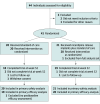Localized Nicardipine Release Implants for Prevention of Vasospasm After Aneurysmal Subarachnoid Hemorrhage: A Randomized Clinical Trial
- PMID: 39158893
- PMCID: PMC11334004
- DOI: 10.1001/jamaneurol.2024.2564
Localized Nicardipine Release Implants for Prevention of Vasospasm After Aneurysmal Subarachnoid Hemorrhage: A Randomized Clinical Trial
Abstract
Importance: Cerebral vasospasm largely contributes to a devastating outcome after aneurysmal subarachnoid hemorrhage (aSAH), with limited therapeutic options.
Objective: To investigate the safety and efficacy of localized nicardipine release implants positioned around the basal cerebral vasculature at risk for developing proximal vasospasm after aSAH.
Design, setting, and participants: This single-masked randomized clinical trial with a 52-week follow-up was performed between April 5, 2020, and January 23, 2023, at 6 academic neurovascular centers in Germany and Austria. Consecutive patients with World Federation of Neurological Surgeons grade 3 or 4 aSAH due to a ruptured anterior circulation aneurysm requiring microsurgical aneurysm repair participated.
Intervention: During aneurysm repair, patients were randomized 1:1 to intraoperatively receive 10 implants at 4 mg of nicardipine each plus standard of care (implant group) or aneurysm repair alone plus standard of care (control group).
Main outcome and measures: The primary end point was the incidence of moderate to severe cerebral angiographic vasospasm (aVS) between days 7 and 9 after aneurysm rupture as determined by digital subtraction angiography.
Results: Of 41 patients, 20 were randomized to the control group (mean [SD] age, 54.9 [9.1] years; 17 female [85%]) and 21 to the implant group (mean [SD] age, 53.6 [11.9] years; 14 female [67%]). A total of 39 patients were included in the primary efficacy analysis. In the control group, 11 of 19 patients (58%) developed moderate or severe aVS compared with 4 of 20 patients (20%) in the implant group (P = .02). This outcome was paralleled by a lower clinical need for vasospasm rescue therapy in the implant group (2 of 20 patients [10%]) compared with the control group (11 of 19 patients [58%]; P = .002). Between days 13 and 15 after aneurysm rupture, new cerebral infarcts were noted in 6 of 19 patients (32%) in the control group and in 2 of 20 patients (10%) in the implant group (P = .13). At 52 weeks, favorable outcomes were noted in 12 of 18 patients (67%) in the control group and 16 of 19 patients (84%) in the implant group (P = .27). The adverse event rate did not differ between groups.
Conclusions and relevance: These findings show that placing nicardipine release implants during microsurgical aneurysm repair can provide safe and effective prevention of moderate to severe aVS after aSAH. A phase 3 clinical trial to investigate the effect of nicardipine implants on clinical outcome may be warranted.
Trial registration: ClinicalTrials.gov Identifier: NCT04269408.
Conflict of interest statement
References
-
- Vergouwen MDI, Vermeulen M, van Gijn J, et al. . Definition of delayed cerebral ischemia after aneurysmal subarachnoid hemorrhage as an outcome event in clinical trials and observational studies: proposal of a multidisciplinary research group. Stroke. 2010;41(10):2391-2395. doi:10.1161/STROKEAHA.110.589275 - DOI - PubMed
Publication types
MeSH terms
Substances
Associated data
LinkOut - more resources
Full Text Sources
Medical
Miscellaneous


